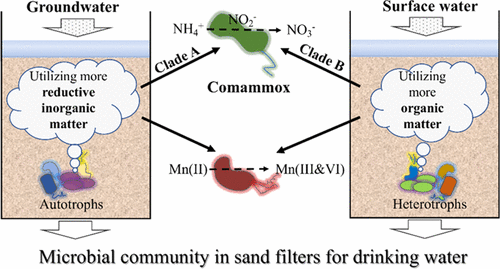当前位置:
X-MOL 学术
›
Environ. Sci. Technol.
›
论文详情
Our official English website, www.x-mol.net, welcomes your
feedback! (Note: you will need to create a separate account there.)
Metagenomics Unravels Differential Microbiome Composition and Metabolic Potential in Rapid Sand Filters Purifying Surface Water Versus Groundwater.
Environmental Science & Technology ( IF 10.8 ) Pub Date : 2020-04-02 , DOI: 10.1021/acs.est.9b07143 Wanchao Hu 1, 2 , Jinsong Liang 1, 3 , Feng Ju 4, 5 , Qiaojuan Wang 1, 2 , Ruiping Liu 1 , Yaohui Bai 1 , Huijuan Liu 6 , Jiuhui Qu 1
Environmental Science & Technology ( IF 10.8 ) Pub Date : 2020-04-02 , DOI: 10.1021/acs.est.9b07143 Wanchao Hu 1, 2 , Jinsong Liang 1, 3 , Feng Ju 4, 5 , Qiaojuan Wang 1, 2 , Ruiping Liu 1 , Yaohui Bai 1 , Huijuan Liu 6 , Jiuhui Qu 1
Affiliation

|
Designed for retaining suspended particles, rapid sand filters (RSFs) are widely used in drinking water treatment. There is increasing evidence that microbial processes within RSFs contribute to the transformation and removal of organic carbon, nitrogen, and metal pollutants. Here, we linked microbial composition and functional profiles with the treatment performance of 12 different RSFs that significantly removed influent ammonium and manganese (Mn). Metagenomic analyses showed that chemoautotrophic or methanotrophic bacteria were prevalent in the groundwater filters, and chemoheterotrophic bacteria encoding more carbohydrate- and xenobiotic-metabolizing genes were more abundant in the surface water filters. Approximately 92% of ammonium was transformed into nitrate, with a critical contribution from comammox Nitrospira. The composition of comammox amoA differed between groundwater and surface water filters, with clade A dominating groundwater filters (78.0 ± 12.0%) and clade B dominating surface water filters (91.9 ± 8.9%). Further, we identified six bacterial genera encoding known Mn(II)-oxidizing genes in the RSFs, with Pseudomonas accounting for 71.1%. These Mn(II)-oxidizing bacteria might promote Mn(II) oxidation and thus increase the removal of influent Mn. Overall, our study gave a comprehensive investigation of microbiome in RSFs and highlighted the roles of comammox and Mn(II)-oxidizing bacteria in water purification.
中文翻译:

元基因组学揭示了快速砂滤器中净化地表水和地下水的差异微生物组组成和代谢潜能。
快速沙滤器(RSF)专为保留悬浮颗粒而设计,广泛用于饮用水处理中。越来越多的证据表明,RSF中的微生物过程有助于转化和去除有机碳,氮和金属污染物。在这里,我们将微生物组成和功能特性与12种不同的RSF的处理性能相关联,这些RSF显着去除了流入的铵和锰(Mn)。元基因组学分析表明,在地下水过滤器中普遍存在化学自养或甲烷营养细菌,而在地表水过滤器中编码更多碳水化合物和异种生物代谢基因的化学营养细菌更为丰富。大约92%的铵转化为硝酸盐,其中Comammox Nitrospira起到了关键作用。comammox amoA的组成在地下水过滤器和地表水过滤器之间有所不同,其中进化枝A占主导地位(78.0±12.0%),进化枝B占主导地位(91.9±8.9%)。此外,我们确定了六个细菌属,在RSF中编码已知的Mn(II)氧化基因,其中假单胞菌占71.1%。这些Mn(II)氧化细菌可能会促进Mn(II)氧化,从而增加进水Mn的去除。总体而言,我们的研究对RSF中的微生物组进行了全面调查,并强调了Comammox和Mn(II)氧化细菌在水净化中的作用。我们确定了六个细菌属,在RSF中编码已知的Mn(II)氧化基因,其中假单胞菌占71.1%。这些Mn(II)氧化细菌可能会促进Mn(II)氧化,从而增加进水Mn的去除。总体而言,我们的研究对RSF中的微生物组进行了全面调查,并强调了Comammox和Mn(II)氧化细菌在水净化中的作用。我们确定了六个细菌属,在RSF中编码已知的Mn(II)氧化基因,其中假单胞菌占71.1%。这些Mn(II)氧化细菌可能会促进Mn(II)氧化,从而增加进水Mn的去除。总体而言,我们的研究对RSF中的微生物组进行了全面调查,并强调了Comammox和Mn(II)氧化细菌在水净化中的作用。
更新日期:2020-04-23
中文翻译:

元基因组学揭示了快速砂滤器中净化地表水和地下水的差异微生物组组成和代谢潜能。
快速沙滤器(RSF)专为保留悬浮颗粒而设计,广泛用于饮用水处理中。越来越多的证据表明,RSF中的微生物过程有助于转化和去除有机碳,氮和金属污染物。在这里,我们将微生物组成和功能特性与12种不同的RSF的处理性能相关联,这些RSF显着去除了流入的铵和锰(Mn)。元基因组学分析表明,在地下水过滤器中普遍存在化学自养或甲烷营养细菌,而在地表水过滤器中编码更多碳水化合物和异种生物代谢基因的化学营养细菌更为丰富。大约92%的铵转化为硝酸盐,其中Comammox Nitrospira起到了关键作用。comammox amoA的组成在地下水过滤器和地表水过滤器之间有所不同,其中进化枝A占主导地位(78.0±12.0%),进化枝B占主导地位(91.9±8.9%)。此外,我们确定了六个细菌属,在RSF中编码已知的Mn(II)氧化基因,其中假单胞菌占71.1%。这些Mn(II)氧化细菌可能会促进Mn(II)氧化,从而增加进水Mn的去除。总体而言,我们的研究对RSF中的微生物组进行了全面调查,并强调了Comammox和Mn(II)氧化细菌在水净化中的作用。我们确定了六个细菌属,在RSF中编码已知的Mn(II)氧化基因,其中假单胞菌占71.1%。这些Mn(II)氧化细菌可能会促进Mn(II)氧化,从而增加进水Mn的去除。总体而言,我们的研究对RSF中的微生物组进行了全面调查,并强调了Comammox和Mn(II)氧化细菌在水净化中的作用。我们确定了六个细菌属,在RSF中编码已知的Mn(II)氧化基因,其中假单胞菌占71.1%。这些Mn(II)氧化细菌可能会促进Mn(II)氧化,从而增加进水Mn的去除。总体而言,我们的研究对RSF中的微生物组进行了全面调查,并强调了Comammox和Mn(II)氧化细菌在水净化中的作用。











































 京公网安备 11010802027423号
京公网安备 11010802027423号